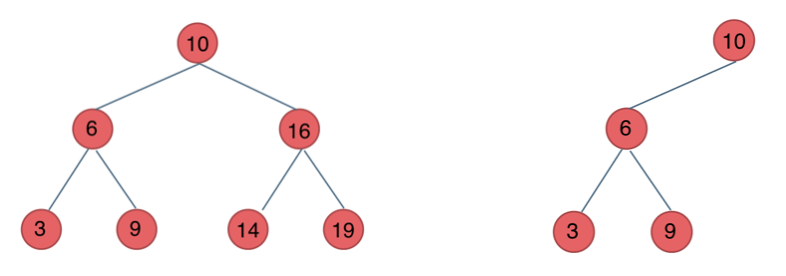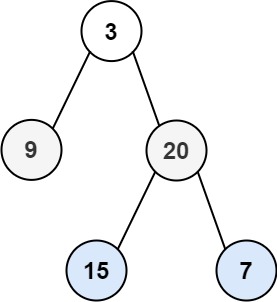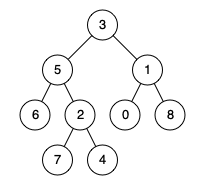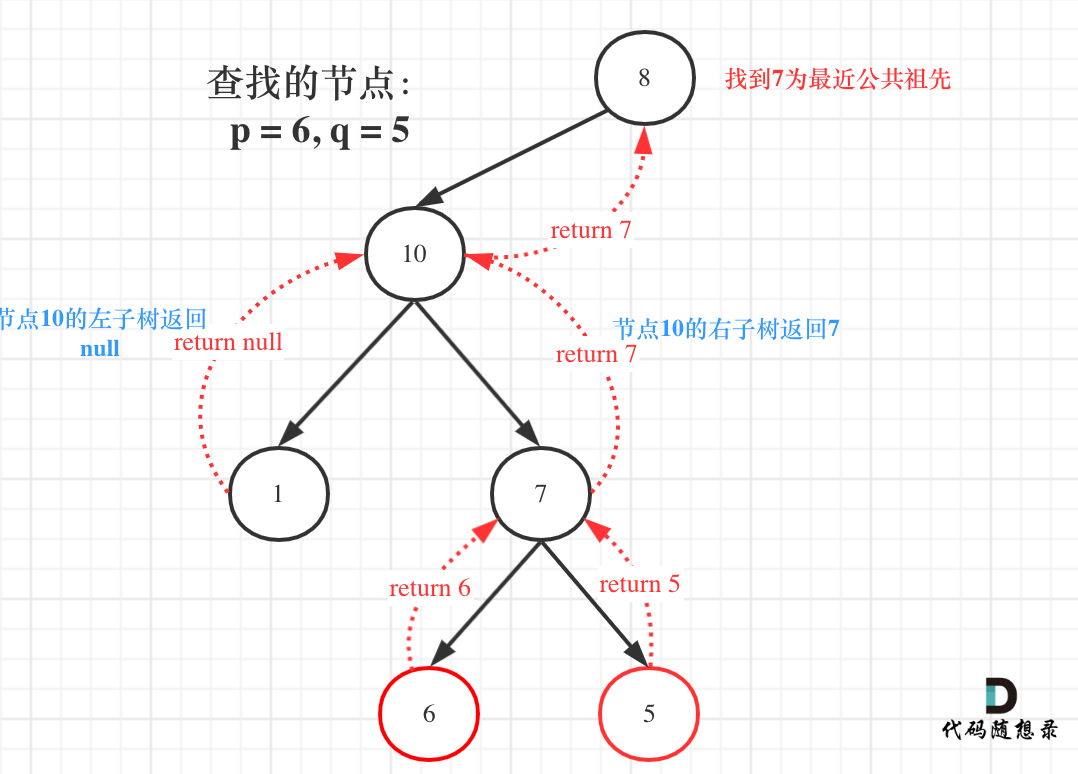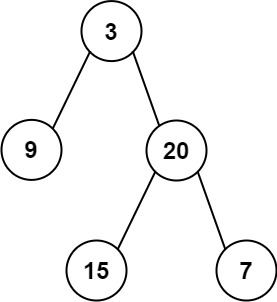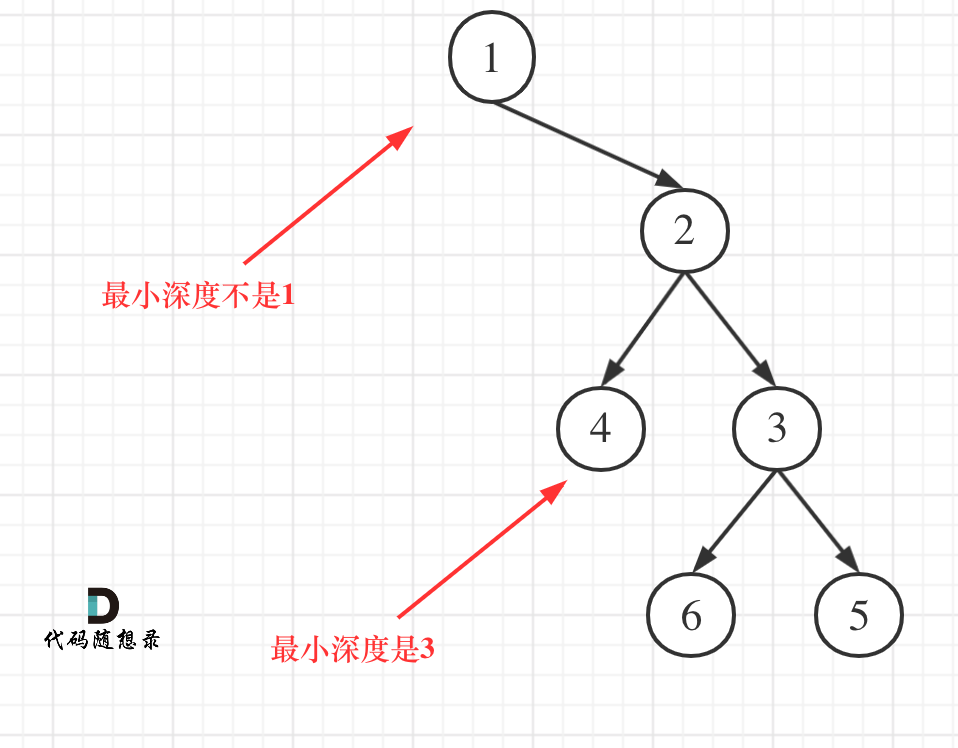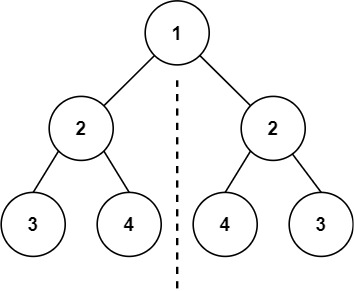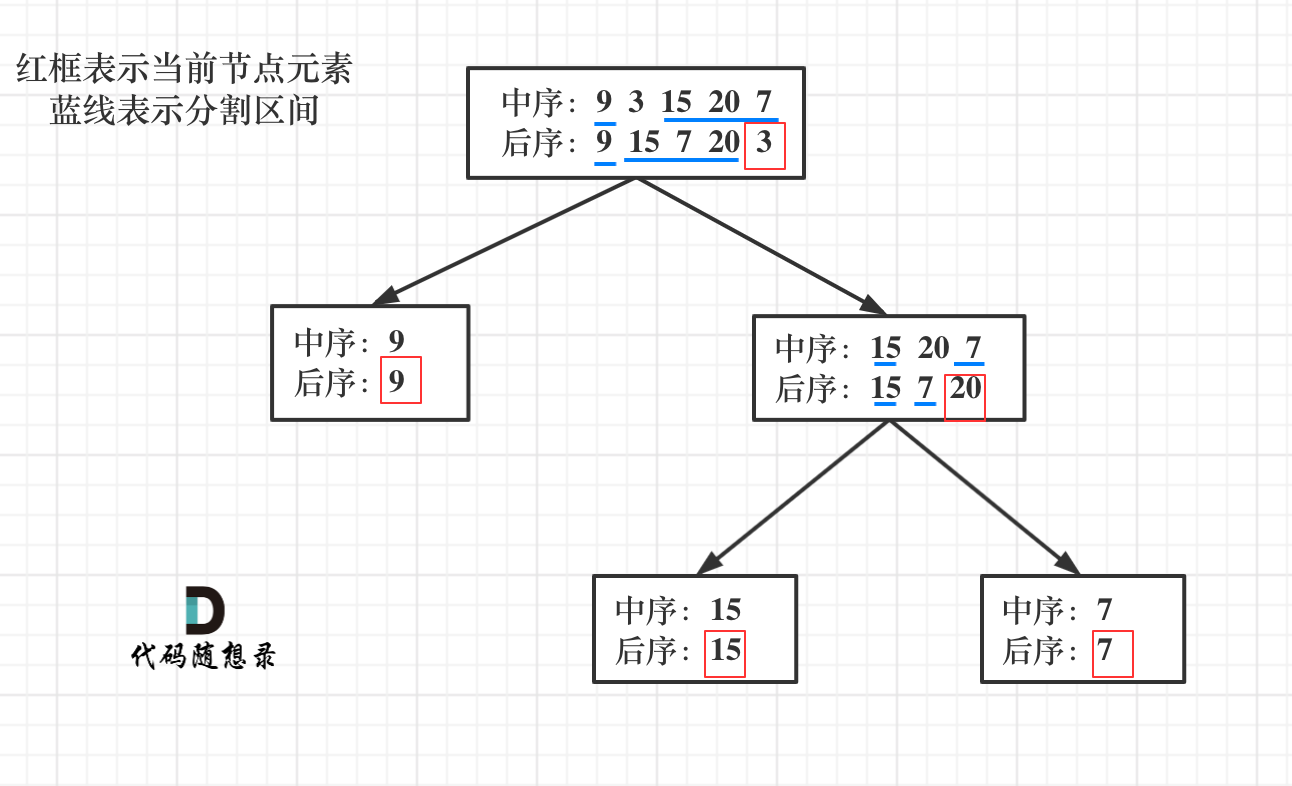基础知识
二叉树的定义
1 2 3 4 5 6 7 8 9 10 11 12 public class TreeNode int val;int val) { this .val = val; }int val, TreeNode left, TreeNode right) {this .val = val;this .left = left;this .right = right;
二叉树种类
满二叉树: 每一层都是满的,第k层有2k-1 个节点
完全二叉树: 最下面一层的节点都集中在该层最左边的若干位置。若最底层为第 h 层,则该层包含 1~ 2h-1 个节点。
优先级队列其实是一个堆,堆就是一棵完全二叉树,同时保证父子节点的顺序关系。
二叉搜索树: 有 数值 , 二叉搜索树是一个有序树 。
若它的左子树不空,则左子树上所有结点的值均小于它的根结点的值;
若它的右子树不空,则右子树上所有结点的值均大于它的根结点的值;
它的左、右子树也分别为二叉排序树
下面这两棵树都是搜索树
平衡二叉搜索树(AVL(Adelson-Velsky and Landis)树)
它是一棵 空树 或它的左右两个子树的 高度差 的绝对值不超过1,并且左右两个子树都是一棵平衡二叉树。
C++中map、set、multimap,multiset的底层实现都是平衡二叉搜索树 ,所以map、set的增删操作时间时间复杂度是logn,注意我这里没有说unordered_map、unordered_set,unordered_map、unordered_map底层实现是哈希表。
二叉树的存储方式
二叉树可以链式存储,也可以顺序存储(用数组)。
用数组来存储二叉树如何遍历的呢?
如果父节点的数组下标是 i,那么它的左孩子就是 i * 2 + 1,右孩子就是 i * 2 + 2。
但是用链式表示的二叉树,更有利于我们理解,所以一般我们都是用链式存储二叉树。
二叉树的遍历方式
深度优先遍历
前序遍历(递归法,迭代法):中左右
中序遍历(递归法,迭代法):左中右
后序遍历(递归法,迭代法):左右中
广度优先遍历
递归遍历
递归算法三要素
确定递归函数的参数和返回值: 确定哪些参数是递归的过程中需要处理的,那么就在递归函数里加上这个参数, 并且还要明确每次递归的返回值是什么进而确定递归函数的返回类型。确定终止条件: 写完了递归算法, 运行的时候,经常会遇到栈溢出的错误,就是没写终止条件或者终止条件写的不对,操作系统也是用一个栈的结构来保存每一层递归的信息,如果递归没有终止,操作系统的内存栈必然就会溢出。确定单层递归的逻辑: 确定每一层递归需要处理的信息。在这里也就会重复调用自己来实现递归的过程。
1 2 3 4 5 6 7 8 9 10 11 12 13 14 15 16 17 18 19 20 class Solution ArrayList<Integer> preOrderReverse (TreeNode root) {new ArrayList<Integer>();return result;void preOrder (TreeNode root, ArrayList<Integer> result) if (root == null ) { return ;
1 2 3 4 5 6 7 8 9 10 11 12 13 14 15 16 17 class Solution public List<Integer> inorderTraversal (TreeNode root) new ArrayList<>();return res;void inorder (TreeNode root, List<Integer> list) if (root == null ) {return ;
1 2 3 4 5 6 7 8 9 10 11 12 13 14 15 16 17 class Solution public List<Integer> postorderTraversal (TreeNode root) new ArrayList<>();return res;void postorder (TreeNode root, List<Integer> list) if (root == null ) {return ;
迭代遍历
用栈的方式实现
前序遍历中访问节点(遍历节点)和处理节点(将元素放进result数组中)可以同步处理,但是中序就无法做到同步!
按顺序将节点入栈,入栈的同时输出到result,到空的时候出栈,找右节点
1 2 3 4 5 6 7 8 9 10 11 12 13 14 15 16 17 18 19 20 21 22 23 24 25 class Solution public List<Integer> preorderTraversal (TreeNode root) new ArrayList<Integer>();if (root == null ) {return res;new LinkedList<TreeNode>();while (!stack.isEmpty() || node != null ) {while (node != null ) {return res;
改掉二重循环
—— 出栈的时候把节点值加入result,要求中节点入栈后,先将右节点入栈,再将左节点入栈
1 2 3 4 5 6 7 8 9 10 11 12 13 14 15 16 17 18 19 20 21 22 class Solution public List<Integer> preorderTraversal (TreeNode root) new ArrayList<>();if (root == null ){return result;new LinkedList<TreeNode>();while (!stack.isEmpty()){if (node.right != null ){if (node.left != null ){return result;
按顺序将节点入栈,出栈的时候把值加入result
1 2 3 4 5 6 7 8 9 10 11 12 13 14 15 16 17 18 19 class Solution public List<Integer> inorderTraversal (TreeNode root) new ArrayList<Integer>();new LinkedList<TreeNode>();while (root != null || !stk.isEmpty()) {while (root != null ) {return res;
与中序的不同之处在于:
中序遍历中,从栈中弹出的节点,其左子树是访问完了,可以直接访问该节点,然后接下来访问右子树。
后序遍历中,从栈中弹出的节点,我们只能确定其左子树肯定访问完了,但是无法确定右子树是否访问过。
因此,我们在后序遍历中,引入了一个prev来记录历史访问记录。
当访问完一棵子树的时候,我们用prev指向该节点。
这样,在回溯到父节点的时候,我们可以依据prev是指向左子节点,还是右子节点,来判断父节点的访问情况。
1 2 3 4 5 6 7 8 9 10 11 12 13 14 15 16 17 18 19 20 21 22 23 24 25 26 27 28 29 30 31 32 33 34 35 36 37 38 class Solution public List<Integer> postorderTraversal (TreeNode root) new ArrayList<Integer>();if (root == null ) {return res;new LinkedList<TreeNode>();null ;while (root != null || !stack.isEmpty()) {while (root != null ) {if (root.right == null || root.right == prev) {null ;else {return res;
统一迭代法
将访问的节点放入栈中,把要处理的节点也放入栈中但是要做标记。
如何标记呢,就是要处理的节点放入栈之后,紧接着放入一个空指针作为标记。
1 2 3 4 5 6 7 8 9 10 11 12 13 14 15 16 17 18 19 20 21 22 23 24 class Solution public List<Integer> preorderTraversal (TreeNode root) new LinkedList<>();new LinkedList<TreeNode>();if (root != null ) st.push(root);while (!st.empty()) {if (node != null ) {if (node.right!=null ) st.push(node.right); if (node.left!=null ) st.push(node.left); null ); else { return result;
⭐ 广度优先:层序遍历
示例 1:
1 2 输入:root = [3,9,20,null,null,15,7]
不要把输入当作数组,输入还是树结构!!
方法一:递归,记录树深度
1 2 3 4 5 6 7 8 9 10 11 12 13 14 15 16 17 18 19 20 21 22 23 24 class Solution public List<List<Integer>> result = new ArrayList<List<Integer>>();public List<List<Integer>> levelOrder(TreeNode root) {0 );return result;public void levelDFS (TreeNode root, int level) if (root==null )return ;if (result.size()<level+1 ){new ArrayList<Integer>();1 );1 );
方法二:迭代,可借助队列实现
1 2 3 4 5 6 7 8 9 10 11 12 13 14 15 16 17 18 19 20 21 22 23 24 25 26 27 28 class Solution public List<List<Integer>> result = new ArrayList<List<Integer>>();public List<List<Integer>> levelOrder(TreeNode root) {if (root == null ) return result;new LinkedList<TreeNode>();while (!que.isEmpty()){new ArrayList<Integer>();int len = que.size();while (len>0 ){if (curNode.left!=null ) que.offer(curNode.left);if (curNode.right!=null ) que.offer(curNode.right);return result;
相关题:
⭐ 递归函数的返回值
递归函数什么时候需要返回值?什么时候不需要返回值?这里总结如下三点:
如果需要搜索整棵二叉树且不用处理 递归返回值,递归函数就不要返回值。(113.路径总和ii)
如果需要搜索整棵二叉树且需要处理 递归返回值,递归函数就需要返回值。 (这种情况我们在236. 二叉树的最近公共祖先 (opens new window) 中介绍)
如果要搜索其中一条符合条件的路径 ,那么递归一定需要返回值,因为遇到符合条件的路径了就要及时返回。(112.路径总和 的情况)
搜索一条边的写法:
1 2 3 if (递归函数(root->left)) return ;
搜索整个树写法:
1 2 3 left = 递归函数(root->left);
⭐ 递归与叶子节点
有些情况下,递归需要在叶子节点处终止,此时在递归左右子节点的时候判断是否为null
1 2 3 4 5 6 7 8 9 10 递归函数(root, ...){if (root.left == null && root.right == null ) {if (root.left!=null ) 递归函数(root.left, ...);if (root.right!=null ) 递归函数(root.right, ...);
给定一个二叉树, 找到该树中两个指定节点的最近公共祖先。
百度百科 中最近公共祖先的定义为:“对于有根树 T 的两个节点 p、q,最近公共祖先表示为一个节点 x,满足 x 是 p、q 的祖先且 x 的深度尽可能大(一个节点也可以是它自己的祖先 )。”
示例 1:
1 2 3 4 输入:root = [3,5,1,6,2,0,8,null,null,7,4], p = 5, q = 1
思路
❌错解:
✔️正解:
遍历方式选择: 自底向上查找 --> 二叉树回溯 --> 后序遍历(最先处理的是叶子节点)
如果找到一个节点,发现左子树出现结点p,右子树出现节点q,或者 左子树出现结点q,右子树出现节点p,那么该节点就是节点p和q的最近公共祖先。
递归三部曲:
1 2 3 4 5 6 7 8 9 10 11 12 13 14 15 16 17 18 19 20 21 class Solution public TreeNode lowestCommonAncestor (TreeNode root, TreeNode p, TreeNode q) if (root == null || root == p|| root == q) {return root;if (left == null && right == null ) { return left;else if (left !=null && right != null ) { return root;else if (left !=null ){ return left;else {return right;
给定一个非空二叉树的根节点 root , 以数组的形式返回每一层节点的平均值。与实际答案相差 10-5 以内的答案可以被接受。
示例 1:
1 2 3 4 输入:root = [3,9,20,null,null,15,7]
思路: 层序遍历
注意点:
1 2 3 4 5 6 7 8 9 10 11 12 13 14 15 16 17 18 19 20 21 22 23 24 25 26 27 28 29 30 31 32 33 class Solution public List<Double> averageOfLevels (TreeNode root) new ArrayList<Double>();new LinkedList<TreeNode>();while (!que.isEmpty()){double sum = 0 ; int len = 0 ;int lenq = que.size(); while (len < lenq){if (curNode.left!=null ) que.offer(curNode.left);if (curNode.right!=null ) que.offer(curNode.right);if (!que.isEmpty()) {return result;
给定一个二叉树,找出其最大深度。
示例: [3,9,20,null,null,15,7],
返回它的最大深度 3 。
⭐ 思路一: 深度=自底而上–>后序遍历
1 2 3 4 5 6 7 8 9 10 11 12 13 14 class Solution public int maxDepth (TreeNode root) if (root==null ) {return 0 ;int deepl = maxDepth(root.left);int deepr = maxDepth(root.right);return deepl>deepr?(deepl+1 ):(deepr+1 );
思路二: 迭代法 层序遍历,记录深度
1 2 3 4 5 6 7 8 9 10 11 12 13 14 15 16 17 18 19 20 21 22 23 24 25 26 27 class solution public int maxdepth (treenode root) if (root == null ) {return 0 ;new LinkedList<>();int depth = 0 ;while (!deque.isempty()) {int size = deque.size();for (int i = 0 ; i < size; i++) {if (poll.left != null ) {if (poll.right != null ) {return depth;
方法一: 递归法
后序遍历
❌误区:
不能仿照二叉树的最大深度 写如下代码:
1 2 3 int leftDepth = getDepth(node.left);
这个代码就犯了此图中的误区:
如果这么求的话,没有左孩子的分支会算为最短深度。
✔️正解
左子树为空,右子树不为空,说明最小深度是 1 + 右子树的深度。
右子树为空,左子树不为空,最小深度是 1 + 左子树的深度。 最后如果左右子树都不为空,返回左右子树深度最小值 + 1
左右子树都不为空,按上面的写法
1 2 3 4 5 6 7 8 9 10 11 12 13 14 15 16 class Solution public int minDepth (TreeNode root) if (root==null ) {return 0 ;int deepl = minDepth(root.left);int deepr = minDepth(root.right);if (root.left==null ) {return deepr+1 ;else if (root.right==null ){return deepl+1 ;else {return Math.min(deepl,deepr)+1 ;
方法二:迭代法
判断如果是叶子节点,直接返回
1 2 3 4 5 6 7 8 9 10 11 12 13 14 15 16 17 18 19 20 21 22 23 24 class Solution public int minDepth (TreeNode root) if (root==null ) {return 0 ;new LinkedList<>();int deep = 0 ;while (!que.isEmpty()) {int len = que.size();while (len>0 ){if (curNode.left==null &&curNode.right==null ) {return deep;if (curNode.left != null ) que.offer(curNode.left);if (curNode.right != null ) que.offer(curNode.right);return deep;
最大深度是指从根节点到最远叶子节点的最长路径上的节点总数。
N 叉树输入按层序遍历序列化 表示 ,每组子节点由空值分隔(请参见示例)。(表示方法而已!)
⭐N叉树表示方法示例:
1 2 3 4 5 6 7 8 9 10 11 12 13 14 15 class Node public int val;public List<Node> children;public Node () public Node (int _val) public Node (int _val, List<Node> _children)
思路:
和二叉树的最大深度 类似,左右子节点变为遍历一个列表的孩子节点
1 2 3 4 5 6 7 8 9 10 11 12 13 class Solution public int maxDepth (Node root) if (root == null ) {return 0 ;int maxd = 0 ;for (Node i: root.children) {int di = maxDepth(i);return maxd+1 ;
给定一棵二叉树,你需要计算它的直径长度。一棵二叉树的直径长度是任意两个结点路径长度中的最大值。这条路径可能穿过也可能不穿过根结点。
示例 :
返回 3 , 它的长度是路径 [4,2,1,3] 或者 [5,2,1,3]。
思路
长度 = 左子树深度 + 右子树深度
1 2 3 4 5 6 7 8 9 10 11 12 13 14 15 16 17 18 19 class Solution public int maxL = 0 ;public int diameterOfBinaryTree (TreeNode root) int deep = getDepth(root);return maxL; public int getDepth (TreeNode node) if (node == null ) {return 0 ;int deepl = getDepth(node.left);int deepr = getDepth(node.right);return Math.max(deepl, deepr)+1 ;
给你一棵 完全二叉树 的根节点 root ,求出该树的节点个数。
完全二叉树 的定义如下:在完全二叉树中,除了最底层节点可能没填满外,其余每层节点数都达到最大值,并且最下面一层的节点都集中在该层最左边的若干位置。若最底层为第 h 层,则该层包含 1~ 2h 个节点。
思路: 利用完全二叉树的性质
完全二叉树只有两种情况:
完全二叉树获得深度只需要不断遍历左节点就行了
1 2 3 4 5 6 7 8 9 10 11 12 13 14 15 16 17 18 19 20 21 22 23 24 25 class Solution public int countNodes (TreeNode root) if (root==null ) return 0 ;int depL = getDepth(root.left);int depR = getDepth(root.right);if (depL==depR) {return (1 <<depL)-1 + countNodes(root.right) + 1 ; else {return (1 <<depR)-1 + countNodes(root.left) + 1 ;public int getDepth (TreeNode root) int depth = 0 ;while (root != null ){return depth;
时间复杂度:$O(\log^2 n)$
给定一个二叉树,判断它是否是高度平衡的二叉树。
本题中,一棵高度平衡二叉树定义为:
一个二叉树每个节点 的左右两个子树的高度差的绝对值不超过 1 。
思路: 递归算深度,设置标志位-1
1 2 3 4 5 6 7 8 9 10 11 12 13 14 15 16 17 18 19 20 21 22 23 24 class Solution public boolean isBalanced (TreeNode root) if (getDepth(root)==-1 ) {return false ;return true ;public int getDepth (TreeNode root) if (root==null ) {return 0 ;int dL = getDepth(root.left);int dR = getDepth(root.right);if (dL==-1 || dR==-1 || Math.abs(dL-dR)>1 ) {return -1 ;return Math.max(dL, dR)+1 ;
给你一棵二叉树的根节点 root ,翻转这棵二叉树,并返回其根节点。
思路:
先序遍历/后序遍历二叉树,交换左右节点
1 2 3 4 5 6 7 8 9 10 11 12 13 14 15 16 17 18 19 class Solution public TreeNode invertTree (TreeNode root) if (root == null ) {return root;return root;public void swapNode (TreeNode root)
给你一个二叉树的根节点 root , 检查它是否轴对称。
示例 1:
1 2 输入:root = [1,2,2,3,4,4,3]
思路
1 2 3 4 5 6 7 8 9 10 11 12 13 14 15 16 17 18 19 20 21 22 23 24 25 26 class Solution public boolean isSymmetric (TreeNode root) return biPostOrder(root.left, root.right);public boolean biPostOrder (TreeNode rootL, TreeNode rootR) if ((rootL == null && rootR != null ) || (rootL != null && rootR == null )) {return false ;if (rootL == null && rootR == null ) {return true ;if (rootL.val != rootR.val) {return false ;return (
给你一个二叉树的根节点 root ,按 任意顺序 ,返回所有从根节点到叶子节点的路径。
叶子节点 是指没有子节点的节点。
思路:
用先序遍历,在叶子节点处终止
1 2 3 4 5 6 7 8 9 10 11 12 13 14 15 16 17 18 class Solution public List<String> paths = new ArrayList<>();public List<String> binaryTreePaths (TreeNode root) "" );return paths;public void findPath (TreeNode root, String path) "->" + String.valueOf(root.val);if (root.left == null && root.right == null ) {2 )); return ;if (root.left != null ) findPath(root.left, path);if (root.right != null ) findPath(root.right, path);
给定二叉搜索树(BST)的根节点 root 和一个整数值 val。
你需要在 BST 中找到节点值等于 val 的节点。 返回以该节点为根的子树。 如果节点不存在,则返回 null 。
递归法
1 2 3 4 5 6 7 8 9 10 11 12 13 class Solution public TreeNode searchBST (TreeNode root, int val) if (root == null || root.val == val) {return root;if (val < root.val) {return searchBST(root.left, val);else {return searchBST(root.right, val);
迭代法
1 2 3 4 5 6 7 8 9 10 11 12 13 14 15 16 17 18 class Solution public TreeNode searchBST (TreeNode root, int val) while (root != null ) {if (root.val == val) {return root;if (root.val > val) {else {return root;
清楚定义就行
⭐ 构造二叉树
给定两个整数数组 inorder 和 postorder ,其中 inorder 是二叉树的中序遍历, postorder 是同一棵树的后序遍历,请你构造并返回这颗 二叉树 。
例如,给出
中序遍历 inorder = [9,3,15,20,7] 后序遍历 postorder = [9,15,7,20,3] 返回如下的二叉树:
思路
后序遍历:左右中
中序遍历:左中右
通过后序遍历,从后往前,可以确定根节点
然后通过中序遍历,确定左子树的大小
逻辑:
后序找根root
遍历中序到根,确定左子树长度llen
后序中根据左子树长度,找到左子树的根
root_l = post_start+llen-1;
算出后序中右子树起始位置post_start_r = post_start+llen;
左子树起始即原来的起始位置
post_start_l = post_start;
中序遍历再+1得到右子树在中序遍历中的起始位置
in_start_r = in_start+llen+1;
左子树的起始位置即原来的起始位置
in_start_l = in_start;
右子树的根就是后序遍历中的下一个
root_r = root-1;
终止:
通过后序的长度来判断元素个数
没有元素:返回Null
只剩一个元素(叶子节点),返回节点
1 2 3 4 5 6 7 8 9 10 11 12 13 14 15 16 17 18 19 20 21 22 23 24 25 26 27 28 29 30 31 32 33 34 35 36 37 38 39 class Solution public TreeNode buildTree (int [] inorder, int [] postorder) return buildTree1(inorder, postorder, 0 , 0 , postorder.length-1 );public TreeNode buildTree1 (int [] inorder, int [] postorder, int in_start, int post_start, int root) if (root-post_start+1 <1 ) {return null ;if (root-post_start+1 ==1 ) {return new TreeNode(postorder[root]);new TreeNode(postorder[root]); int llen = 0 ; for (int i = in_start; i < inorder.length ; i++) {if (inorder[i]==postorder[root]) {break ;int root_l = post_start+llen-1 ;int root_r = root-1 ;int post_start_l = post_start;int post_start_r = post_start+llen;int in_start_l = in_start;int in_start_r = in_start+llen+1 ;return node;
1 2 3 4 5 6 7 8 9 10 11 12 13 14 15 16 17 18 19 20 21 22 23 24 25 26 27 28 29 30 31 32 33 34 35 36 37 38 39 40 class Solution public TreeNode buildTree (int [] preorder, int [] inorder) return buildTree1(preorder, inorder, 0 , 0 , preorder.length-1 );public TreeNode buildTree1 (int [] preorder, int [] inorder, int in_start, int root, int pre_end) if (root>pre_end) {return null ;new TreeNode(preorder[root]);if (root==pre_end) {return node;int llen = 0 ;for (int i = in_start; i < inorder.length; i++) {if (inorder[i]==preorder[root]) {break ;int in_start_l = in_start;int in_start_r = in_start+llen+1 ;int root_l = root+1 ;int root_r = root+llen+1 ;int pre_end_l = root+llen;int pre_end_r = pre_end; return node;
前序和后序不能唯一确定一棵二叉树! ,因为没有中序遍历无法确定左右部分,也就是无法分割。
另一个方法 : 图解算法数据结构 - LeetBook - 力扣(LeetCode)全球极客挚爱的技术成长平台 (leetcode-cn.com)
先遍历一遍中序的数组,以(值,下标)的形式存储到dict里,用的时候直接取出即可
1 2 3 4 5 6 7 8 9 10 11 12 13 14 15 16 17 18 19 20 21 22 23 24 25 26 class Solution new HashMap<>();public TreeNode buildTree (int [] preorder, int [] inorder) int i=0 ;for (int value:inorder) {0 , inorder, 0 , preorder.length-1 );return root;TreeNode helper (int [] preorder, int root, int [] inorder, int start, int end) {if (root > end) {return null ;new TreeNode(preorder[root]);int p = map.get(preorder[root]); int leftLen = p - start;int left = root+1 ;int right = left+leftLen;1 );1 , end);return node;
1 2 3 4 5 6 7 8 9 10 11 12 13 14 15 16 17 18 19 20 21 22 23 24 class Solution public TreeNode sortedArrayToBST (int [] nums) return buildTree(nums, 0 , nums.length);public TreeNode buildTree (int [] nums, int left, int right) if (left > right - 1 ) {return null ;if (left == right - 1 ) {return new TreeNode(nums[left]);int mid = (left + right) >> 1 ;new TreeNode(nums[mid]);1 , right);return root;
类似: 654. 最大二叉树
给定一个单链表,其中的元素按升序排序,将其转换为高度平衡的二叉搜索树。
本题中,一个高度平衡二叉树是指一个二叉树每个节点 的左右两个子树的高度差的绝对值不超过 1。
思路:
链表–>数组–>二叉树?————额外的空间 ❌(也不是完全不行啦)
✔ 快慢指针找中间的节点
快指针一次移动2,慢指针一次移动1
最后快指针到达右端点或快指针的下一个节点是右端点时,慢指针就可以指向中间节点。
同时,没有必要“先”找到中间节点:我们可以使用 中序遍历 先构建了左子树,建立结束后,指针自然指向中间结点。
1 2 3 4 5 6 7 8 9 10 11 12 13 14 15 16 17 18 19 20 21 22 23 24 25 26 27 28 29 class Solution public ListNode helpHead;public TreeNode sortedListToBST (ListNode head) int len = getListLength(head);return helper(0 , len);public int getListLength (ListNode head) int cnt = 0 ;while (head != null ) {return cnt;public TreeNode helper (int left, int right) if (left > right - 1 ) return null ;int mid = (left + right) >> 1 ;new TreeNode();1 , right);return root;
给定二叉搜索树(BST)的根节点和要插入树中的值,将值插入二叉搜索树。 返回插入后二叉搜索树的根节点。 输入数据保证,新值和原始二叉搜索树中的任意节点值都不同。
注意,可能存在多种有效的插入方式,只要树在插入后仍保持为二叉搜索树即可。 你可以返回任意有效的结果。
思路:
不需要改变二叉树结构
只要按照二叉搜索树的规则去遍历,遇到空节点就插入节点就可以了
1 2 3 4 5 6 7 8 9 10 11 12 13 class Solution public TreeNode insertIntoBST (TreeNode root, int val) if (root == null ) return new TreeNode(val);if (root.val < val){else if (root.val > val){return root;
给定一个二叉搜索树的根节点 root 和一个值 key ,删除二叉搜索树中的 key 对应的节点,并保证二叉搜索树的性质不变。返回二叉搜索树(有可能被更新)的根节点的引用。
一般来说,删除节点可分为两个步骤:
首先找到需要删除的节点;
如果找到了,删除它。
示例 1:
1 2 3 4 5 输入:root = [5,3,6,2,4,null,7], key = 3
思路
假如要删除的节点为叶节点,直接删除
假如要删除的节点左节点不为空但右节点为空,则直接用左节点替换当前节点
假如要删除的节点右节点不为空但左节点为空,则直接用右节点替换当前节点
最后要删除的节点左右均不为空,寻找右子树中最左节点,用这个最左节点(就是后继节点)替换当前节点,并且将最左节点从原位置删除。 代码如下:
1 2 3 4 5 6 7 8 9 10 11 12 13 14 15 16 17 18 19 20 21 22 23 24 25 26 27 28 29 30 31 class Solution public TreeNode deleteNode (TreeNode root, int key) if (root == null ) return null ;return helper(root, key);public TreeNode helper (TreeNode root, int key) if (root == null ) {return null ;if (root.val > key) {else if (root.val < key) {else {if (root.left == null ) return root.right; if (root.right == null ) return root.left;while (tmp.left != null ) {return root;
序列化是将数据结构或对象转换为一系列位的过程,以便它可以存储在文件或内存缓冲区中,或通过网络连接链路传输,以便稍后在同一个或另一个计算机环境中重建。
设计一个算法来序列化和反序列化 二叉搜索树 。 对序列化/反序列化算法的工作方式没有限制。 您只需确保二叉搜索树可以序列化为字符串,并且可以将该字符串反序列化为最初的二叉搜索树。
编码的字符串应尽可能紧凑。
思路
序列化:后序遍历
反序列化:最后一个节点是root,从后往前搜索第一个小于根节点的就是左子树的根
编码:用4位十六进制编码会缩短空间
十六进制转换为十进制: Integer.parseInt(String s, 16)
十进制转换为4位十六进制(十六进制格式化)
String.format(“%04x”, num)
1 2 3 4 5 6 7 8 9 10 11 12 13 14 15 16 17 18 19 20 21 22 23 24 25 26 27 28 29 30 31 32 33 34 35 36 37 38 39 40 41 42 43 44 45 46 47 48 49 50 51 52 53 54 55 56 57 58 59 60 61 62 63 64 65 66 67 68 69 70 71 public class Codec public StringBuilder sb = new StringBuilder(); public String serialize (TreeNode root) return sb.toString();public void postorder (TreeNode root) if (root==null ) {return ;public TreeNode deserialize (String data) int len = data.length()/4 ;int [] nums = new int [len];for (int i = 0 ; i < len; i++) {4 *i, 4 *(i+1 )));return buildTree(nums, 0 , len-1 );public TreeNode buildTree (int [] nums,int start, int root) if (root<start) {return null ;new TreeNode(nums[root]);if (root==start) {return node;int root_r = root-1 ;int root_l = start-1 ;for (int i = root-1 ; i >= start; i--) {if (nums[i]<=nums[root]) {break ;int start_l = start;int start_r = root_l+1 ;return node;public String encode (int val) return String.format("%04x" , val);public int decode (String val) return Integer.parseInt(val,16 );
1 2 3 4 5 6 7 8 9 10 11 12 13 14 15 16 17 18 19 20 21 22 23 24 25 26 27 28 29 30 31 32 33 34 35 36 37 38 39 40 41 42 43 44 45 46 47 48 49 50 51 52 53 54 55 56 57 58 59 60 61 62 63 class Codec :def __init__ (self ):"" def serialize (self, root ):"""Encodes a tree to a single string. :type root: TreeNode :rtype: str """ if root == None :return "" return self.stdef postOrder (self, root ):if not root:return def encode (self, i: int ):return str (i)+'#' def deserialize (self, data ):"""Decodes your encoded data to tree. :type data: str :rtype: TreeNode """ if not data:return []len (nodes) - 1 print (nodes)def buildTree (root_index, start_index ):if root_index < start_index:return 1 1 while left_root >= start_index and nodes[left_root] > nodes[root_index]:1 1 return nodereturn buildTree(root_index, 0 )def decode (self, data ):'#' )[:-1 ]return [int (e) for e in li]
给你两棵二叉树: root1 和 root2 。
想象一下,当你将其中一棵覆盖到另一棵之上时,两棵树上的一些节点将会重叠(而另一些不会)。你需要将这两棵树合并成一棵新二叉树。合并的规则是:如果两个节点重叠,那么将这两个节点的值相加作为合并后节点的新值;否则,不为 null 的节点将直接作为新二叉树的节点。
返回合并后的二叉树。
注意: 合并过程必须从两个树的根节点开始。
思路:递归
因为不知道两棵树的深度,所以一定是先序遍历,从根节点开始
都不为空,相加,返回
一个为空,一个不为空,返回一个
两个都为空,返回null
1 2 3 4 5 6 7 8 9 10 11 12 13 14 15 16 17 18 19 class Solution public TreeNode mergeTrees (TreeNode root1, TreeNode root2) if (root1==null &&root2==null ) {return null ;if (root1==null &&root2!=null ) {return root2;if (root2==null &&root1!=null ) {return root1;new TreeNode(root1.val+root2.val);return node;
